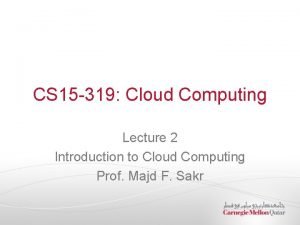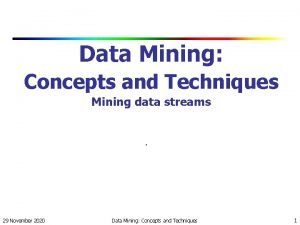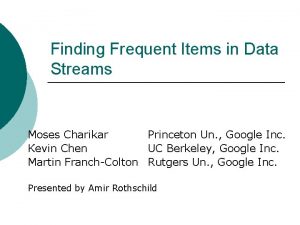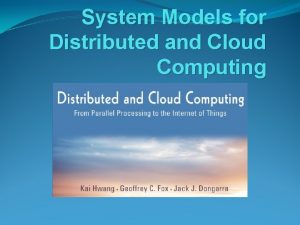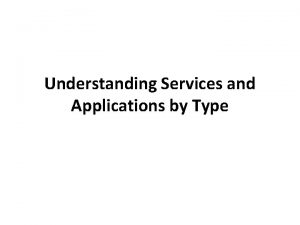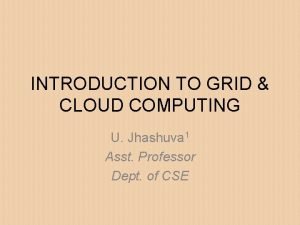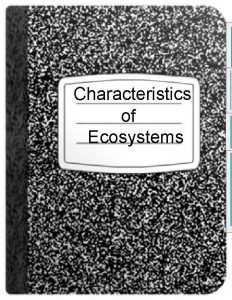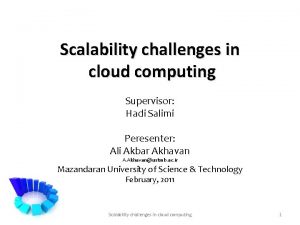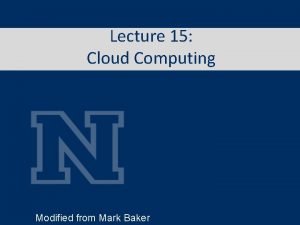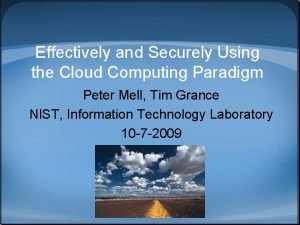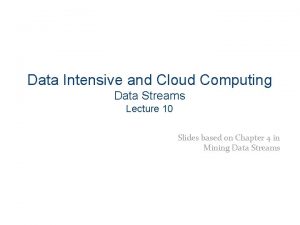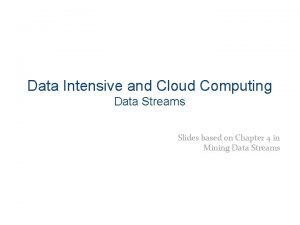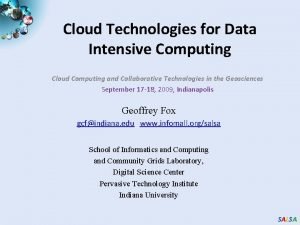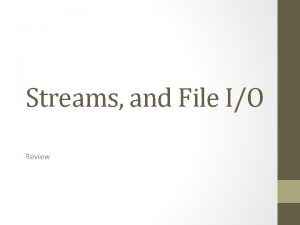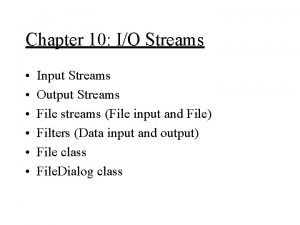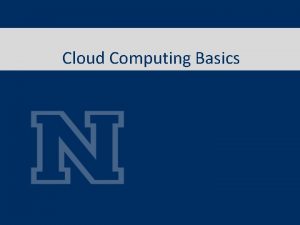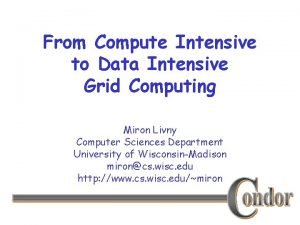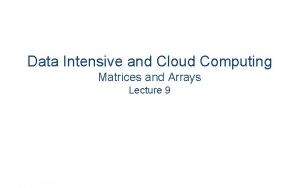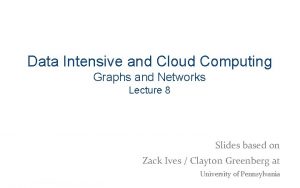Data Intensive and Cloud Computing Data Streams Lecture





























![DGIM Method [Datar, Gionis, Indyk, Motwani] � 30 DGIM Method [Datar, Gionis, Indyk, Motwani] � 30](https://slidetodoc.com/presentation_image/dd5b7b4b83bf7ca936d3e732e2e90011/image-30.jpg)



![Fixup: DGIM method [Datar, Gionis, Indyk, Motwani] �Idea: Instead of summarizing fixed-length blocks, summarize Fixup: DGIM method [Datar, Gionis, Indyk, Motwani] �Idea: Instead of summarizing fixed-length blocks, summarize](https://slidetodoc.com/presentation_image/dd5b7b4b83bf7ca936d3e732e2e90011/image-34.jpg)










- Slides: 44

Data Intensive and Cloud Computing Data Streams Lecture 10 Slides based on Chapter 4 in Mining Data Streams

Data Streams �In many data mining situations, we do not know the entire data set in advance �Stream Management is important when the input rate is controlled externally: § Google queries § Twitter or Facebook status updates �We can think of the data as infinite and non-stationary (the distribution changes over time) 2

What is time series data? �Data that is observed or measured at points in time § Timestamp § Fixed periods § e. g. hours, days, months or years § Or unevenly spaced � Goal is usually prediction § P(xt+1|xt, xt-1, xt-2…) 3

Appears in Many Fields � Robotics � Finance, economics � Marketing � Science, e. g. ecology, earth science � Medicine, e. g. neuroscience � Internet of things 4

Lots of other data are sequences �Text § Sequence of characters or words �Speech recognition § Sequence of sounds (mapped to Cepstral coefficients) �Video § Sequence of sounds and images Goal is ‘translation’, not prediction 5

The Stream Model �Input elements enter at a rapid rate, at one or more input ports (i. e. , streams) § We call elements of the stream tuples �The system cannot store the entire stream accessibly �Q: How do you make critical calculations about the stream using a limited amount of (secondary) memory? 6

Side note: SGD is a Streaming Alg. �Stochastic Gradient Descent (SGD) is an example of a stream algorithm �In Machine Learning we call this: Online Learning § Allows for modeling problems where we have a continuous stream of data § We want an algorithm to learn from it and slowly adapt to the changes in data �Idea: Do slow updates to the model § SGD (SVM, Perceptron) makes small updates § So: First train the classifier on training data. § Then: For every example from the stream, we slightly update the model (using small learning rate) 7

General Stream Processing Model Ad-Hoc Queries Standing Queries . . . 1, 5, 2, 7, 0, 9, 3 Output . . . a, r, v, t, y, h, b. . . 0, 0, 1, 1, 0 time Streams Entering. Each is stream is composed of elements/tuples Processor Limited Working Storage Archival Storage 8

Problems on Data Streams �Types of queries one wants on answer on a data stream: § Sampling data from a stream § Construct a random sample § Queries over sliding windows § Number of items of type x in the last k elements of the stream 9

Problems on Data Streams �Types of queries one wants on answer on a data stream: § Filtering a data stream § Select elements with property x from the stream § Counting distinct elements § Number of distinct elements in the last k elements of the stream § Estimating moments § Estimate avg. /std. dev. of last k elements § Finding frequent elements 10

Applications (1) �Mining query streams § Google wants to know what queries are more frequent today than yesterday �Mining click streams § Yahoo wants to know which of its pages are getting an unusual number of hits in the past hour �Mining social network news feeds § E. g. , look for trending topics on Twitter, Facebook 11

Applications (2) �Sensor Networks § Many sensors feeding into a central controller �Telephone call records § Data feeds into customer bills as well as settlements between telephone companies �IP packets monitored at a switch § Gather information for optimal routing § Detect denial-of-service attacks 12

Sampling from a Data Stream: Sampling a fixed proportion As the stream grows the sample also gets bigger

Sampling from a Data Stream �Since we can not store the entire stream, one obvious approach is to store a sample �Two different problems: § (1) Sample a fixed proportion of elements in the stream (say 1 in 10) § (2) Maintain a random sample of fixed size over a potentially infinite stream § At any “time” k, we keep a random sample of s elements § What is the property of the sample we want to maintain? For all time steps k, each of the s elements seen so far has equal prob. of being sampled 14

Sampling a Fixed Proportion �Problem 1: Sampling fixed proportion �Scenario: Search engine query stream § Stream of tuples: (user, query, time) § Answer questions such as: How often did a user run the same query in a single days? § Have space to store 1/10 th of query stream �Naïve solution: § Generate a random integer in [0. . 9] for each query § Store the query if the integer is 0, otherwise discard 15

Problem with Naïve Approach � 16

Solution: Sample Users Solution: �Pick 1/10 th of users and take all their searches in the sample �Use a hash function that hashes the user name or user id uniformly into 10 buckets 17

Generalized Solution �Stream of tuples with keys: § Key is some subset of each tuple’s components § e. g. , tuple is (user, search, time); key is user § Choice of key depends on application �To get a sample of a/b fraction of the stream: § Hash each tuple’s key uniformly into b buckets § Pick the tuple if its hash value is at most a Hash table with b buckets, pick the tuple if its hash value is at most a. How to generate a 30% sample? Hash into b=10 buckets, take the tuple if it hashes to one of the first 3 buckets 18

Sampling from a Data Stream: Sampling a fixed-size sample As the stream grows, the sample is of fixed size

Maintaining a fixed-size sample �Problem 2: Fixed-size sample �Suppose we need to maintain a random sample S of size exactly s tuples § E. g. , main memory size constraint �Why? Don’t know length of stream in advance �Suppose at time n we have seen n items § Each item is in the sample S with equal prob. s/n How to think about the problem: say s = 2 Stream: a x c y z k c d e g… At n= 5, each of the first 5 tuples is included in the sample S with equal prob. At n= 7, each of the first 7 tuples is included in the sample S with equal prob. Impractical solution would be to store all the n tuples seen so far and out of them pick s at random 20

Solution: Fixed Size Sample �Algorithm (a. k. a. Reservoir Sampling) § Store all the first s elements of the stream to S § Suppose we have seen n-1 elements, and now the nth element arrives (n > s) § With probability s/n, keep the nth element, else discard it § If we picked the nth element, then it replaces one of the s elements in the sample S, picked uniformly at random �Claim: This algorithm maintains a sample S with the desired property: § After n elements, the sample contains each element seen so far with probability s/n 21

Proof: By Induction �We prove this by induction: § Assume that after n elements, the sample contains each element seen so far with probability s/n § We need to show that after seeing element n+1 the sample maintains the property § Sample contains each element seen so far with probability s/(n+1) �Base case: § After we see n=s elements the sample S has the desired property § Each out of n=s elements is in the sample with probability s/s = 1 22

Proof: By Induction � Element n+1 discarded Element n+1 not discarded Element in the sample not picked 23

Queries over a (long) Sliding Window

Sliding Windows �A useful model of stream processing is that queries are about a window of length N – the N most recent elements received �Interesting case: N is so large that the data cannot be stored in memory, or even on disk § Or, there are so many streams that windows for all cannot be stored �Amazon example: § For every product X we keep 0/1 stream of whether that product was sold in the n-th transaction § We want answer queries, how many times have we sold X in the last k sales? 25

Sliding Window: 1 Stream �Sliding window on a single stream: N=6 qwertyuiopasdfghjklzxcvbnm Past Future 26

Counting Bits (1) �Problem: § Given a stream of 0 s and 1 s § Be prepared to answer queries of the form How many 1 s are in the last k bits? where k ≤ N �Obvious solution: Store the most recent N bits § When new bit comes in, discard the N+1 st bit 01001101010110110110 Past Suppose N=6 Future 27

Counting Bits (2) �You cannot get an exact answer without storing the entire window �Real Problem: What if we cannot afford to store N bits? § E. g. , we’re processing 1 billion streams and N = 1 billion 0 1 0 0 1 1 1 0 1 0 1 1 0 Past Future �But we are happy with an approximate answer 28

An attempt: Simple solution � N 0100111000101001011011011100101011010 Past Future 29
![DGIM Method Datar Gionis Indyk Motwani 30 DGIM Method [Datar, Gionis, Indyk, Motwani] � 30](https://slidetodoc.com/presentation_image/dd5b7b4b83bf7ca936d3e732e2e90011/image-30.jpg)
DGIM Method [Datar, Gionis, Indyk, Motwani] � 30

Idea: Exponential Windows �Solution that doesn’t (quite) work: § Summarize exponentially increasing regions of the stream, looking backward § Drop small regions if they begin at the same point Window of as a larger region width 16 has 6 1 s 6 ? 10 4 3 2 2 1 1 0 0100111000101001011011011100101011010 N We can reconstruct the count of the last N bits, except we are not sure how many of the last 6 1 s are included in the N J. Leskovec, A. Rajaraman, J. Ullman: Mining of Massive Datasets, http: //www. mmds. org 31

What’s Good? � J. Leskovec, A. Rajaraman, J. Ullman: Mining of Massive Datasets, http: //www. mmds. org 32

What’s Not So Good? �As long as the 1 s are fairly evenly distributed, the error due to the unknown region is small – no more than 50% �But it could be that all the 1 s are in the unknown area at the end �In that case, the error is unbounded! 6 ? 10 4 3 2 2 1 1 0 0100111000101001011011011100101011010 N J. Leskovec, A. Rajaraman, J. Ullman: Mining of Massive Datasets, http: //www. mmds. org 33
![Fixup DGIM method Datar Gionis Indyk Motwani Idea Instead of summarizing fixedlength blocks summarize Fixup: DGIM method [Datar, Gionis, Indyk, Motwani] �Idea: Instead of summarizing fixed-length blocks, summarize](https://slidetodoc.com/presentation_image/dd5b7b4b83bf7ca936d3e732e2e90011/image-34.jpg)
Fixup: DGIM method [Datar, Gionis, Indyk, Motwani] �Idea: Instead of summarizing fixed-length blocks, summarize blocks with specific number of 1 s: § Let the block sizes (number of 1 s) increase exponentially �When there are few 1 s in the window, block sizes stay small, so errors are small 100101011000101101010101010111010111010100010110010 N J. Leskovec, A. Rajaraman, J. Ullman: Mining of Massive Datasets, http: //www. mmds. org 34

DGIM: Timestamps � J. Leskovec, A. Rajaraman, J. Ullman: Mining of Massive Datasets, http: //www. mmds. org 35

DGIM: Buckets A bucket in the DGIM method is a record consisting of: � § (A) The timestamp of its end [O(log N) bits] § (B) The number of 1 s between its beginning and end [O(log N) bits] � § Constraint on buckets: Number of 1 s must be a power of 2 That explains the O(log N) in (B) above 100101011000101101010101010111010111010100010110010 N J. Leskovec, A. Rajaraman, J. Ullman: Mining of Massive Datasets, http: //www. mmds. org 36

Representing a Stream by Buckets �Either one or two buckets with the same power-of-2 number of 1 s �Buckets do not overlap in timestamps �Buckets are sorted by size § Earlier buckets are not smaller than later buckets �Buckets disappear when their end-time is > N time units in the past J. Leskovec, A. Rajaraman, J. Ullman: Mining of Massive Datasets, http: //www. mmds. org 37

Example: Bucketized Stream At least 1 of size 16. Partially beyond window. 2 of size 8 2 of size 4 1 of size 2 2 of size 1 100101011000101101010101010111010111010100010110010 N Three properties of buckets that are maintained: - Either one or two buckets with the same power-of-2 number of 1 s - Buckets do not overlap in timestamps - Buckets are sorted by size J. Leskovec, A. Rajaraman, J. Ullman: Mining of Massive Datasets, http: //www. mmds. org 38

Updating Buckets (1) �When a new bit comes in, drop the last (oldest) bucket if its end-time is prior to N time units before the current time � 2 cases: Current bit is 0 or 1 �If the current bit is 0: no other changes are needed J. Leskovec, A. Rajaraman, J. Ullman: Mining of Massive Datasets, http: //www. mmds. org 39

Updating Buckets (2) � If the current bit is 1: § (1) Create a new bucket of size 1, for just this bit § End timestamp = current time § (2) If there are now three buckets of size 1, combine the oldest two into a bucket of size 2 § (3) If there are now three buckets of size 2, combine the oldest two into a bucket of size 4 § (4) And so on … J. Leskovec, A. Rajaraman, J. Ullman: Mining of Massive Datasets, http: //www. mmds. org 40

Example: Updating Buckets Current state of the stream: 100101011000101101010101010111010111010100010110010 Bit of value 1 arrives 001010110001011010101010101110101110101000101100101 Two orange buckets get merged into a yellow bucket 001010110001011010101010101110101110101000101100101 Next bit 1 arrives, new orange bucket is created, then 0 comes, then 1: 010110001011010101010101110101110101000101101 Buckets get merged… 010110001011010101010101110101110101000101101 State of the buckets after merging 010110001011010101010101110101110101000101101 J. Leskovec, A. Rajaraman, J. Ullman: Mining of Massive Datasets, http: //www. mmds. org 41

How to Query? � To estimate the number of 1 s in the most recent N bits: 1. Sum the sizes of all buckets but the last (note “size” means the number of 1 s in the bucket) 2. Add half the size of the last bucket � Remember: We do not know how many 1 s of the last bucket are still within the wanted window J. Leskovec, A. Rajaraman, J. Ullman: Mining of Massive Datasets, http: //www. mmds. org 42

Example: Bucketized Stream At least 1 of size 16. Partially beyond window. 2 of size 8 2 of size 4 1 of size 2 2 of size 1 100101011000101101010101010111010111010100010110010 N J. Leskovec, A. Rajaraman, J. Ullman: Mining of Massive Datasets, http: //www. mmds. org 43

Summary �Sampling a fixed proportion of a stream § Sample size grows as the stream grows �Sampling a fixed-size sample § Reservoir sampling �Counting the number of 1 s in the last N elements § Exponentially increasing windows § Extensions: § Number of 1 s in any last k (k < N) elements § Sums of integers in the last N elements J. Leskovec, A. Rajaraman, J. Ullman: Mining of Massive Datasets, http: //www. mmds. org 44
 Cloud computing lecture
Cloud computing lecture Cloud computing lecture
Cloud computing lecture A composable component must be modular
A composable component must be modular Big data in cloud computing ppt
Big data in cloud computing ppt 01:640:244 lecture notes - lecture 15: plat, idah, farad
01:640:244 lecture notes - lecture 15: plat, idah, farad Data nugget streams as sensors answers
Data nugget streams as sensors answers Basic concepts in mining data streams
Basic concepts in mining data streams A framework for clustering evolving data streams
A framework for clustering evolving data streams Finding frequent items in data streams
Finding frequent items in data streams Conventional computing and intelligent computing
Conventional computing and intelligent computing Virtualization structures tools and mechanisms
Virtualization structures tools and mechanisms Distributed system models in cloud computing
Distributed system models in cloud computing Social network and groupware in cloud computing
Social network and groupware in cloud computing The land fatma omara
The land fatma omara Dan c. marinescu
Dan c. marinescu What is cloud computing presentation
What is cloud computing presentation Cloud computing benefits and risks
Cloud computing benefits and risks Pods aggregation and silos in cloud computing
Pods aggregation and silos in cloud computing Grid and cloud computing lmu
Grid and cloud computing lmu Cloud computing places the processing and
Cloud computing places the processing and Grid and cloud computing definition
Grid and cloud computing definition Bill nye rivers and streams
Bill nye rivers and streams Travelers among mountains and streams
Travelers among mountains and streams Streams and rivers abiotic factors
Streams and rivers abiotic factors Vodafone cloud server
Vodafone cloud server Hardware assisted virtualization in cloud computing
Hardware assisted virtualization in cloud computing A type of cloud
A type of cloud Cloud computing reference model
Cloud computing reference model Ardc nectar
Ardc nectar Automated scaling listener
Automated scaling listener Green computing seminar
Green computing seminar Scalability issues in cloud computing
Scalability issues in cloud computing Cloud conclusion
Cloud conclusion Cloud unified management
Cloud unified management Nist architecture in cloud computing
Nist architecture in cloud computing Nimbus in cloud computing
Nimbus in cloud computing Cloud computing cambridge
Cloud computing cambridge Case study on microsoft azure in cloud computing
Case study on microsoft azure in cloud computing Cloud computing layers
Cloud computing layers Regarder introduction to cloud computing vidéos
Regarder introduction to cloud computing vidéos Sejarah cloud computing
Sejarah cloud computing Petr palas
Petr palas Cloud computing tunisie
Cloud computing tunisie Presence in cloud computing
Presence in cloud computing Enterprise cloud computing paradigm
Enterprise cloud computing paradigm
